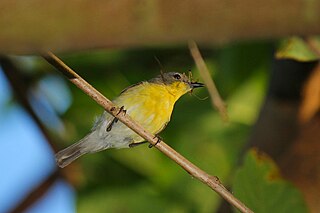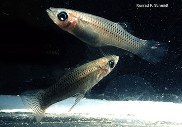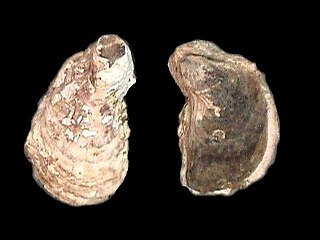
The golden-bellied gerygone is a species of bird in the family Acanthizidae. It is found in Brunei, Indonesia, Malaysia, the Philippines, Singapore, and Thailand. Its natural habitats are subtropical or tropical moist lowland forest and subtropical or tropical mangrove forest.

Pelliciera rhizophorae, known as the tea mangrove, is a less-common species of mangroves found along the Pacific coast from the Gulf of Nicoya in Costa Rica to the Esmeraldas River in Ecuador, as well as within stands located in Nicaragua, Panama, and Colombia. During eras such as the Cenozoic, the species was prevalent. The mangrove hummingbirds of Costa Rica live off the relatively large quantity of nectar produced by its prolific blooms. Pelliciera rhizophorae is the only species in the genus Pelliciera which was previously recognized as the only genus in the family Pellicieraceae, but is now included in the family Tetrameristaceae.

Coptodisca is genus of moths of the family Heliozelidae. It was described by Walsingham in 1895.
Coptodisca arbutiella, the madrone shield bearer, is a moth of the family Heliozelidae. It was described by August Busck in 1904. It is found in western North America from California to British Columbia.
Coptodisca cercocarpella, the curl-leaf mountain mahogany leafminer, is a moth of the family Heliozelidae. It was described by Annette Frances Braun in 1925. It is found in North America, including Arizona, California, Utah and Colorado.
Coptodisca ella is a moth of the family Heliozelidae. It was described by Vactor Tousey Chambers in 1871. It is found in North America, including Tennessee.
Coptodisca saliciella is a moth of the family Heliozelidae. It was described by Clements in 1861. It is found in North America, including California and Ohio.
Coptodisca juglandella is a moth of the family Heliozelidae. It was described by Vactor Tousey Chambers in 1874. It is found in North America, including California, Ohio and Illinois.
Coptodisca kalmiella is a moth of the family Heliozelidae. It was described by Dietz in 1921. It is found in North America, including New Jersey.

Coptodisca lucifluella is a moth of the family Heliozelidae. It was described by James Brackenridge Clemens in 1860. It is found in North America, including Kentucky and Ohio.
Coptodisca magnella is a moth of the family Heliozelidae. It was described by Annette Frances Braun in 1916. It is found in North America, including Kentucky, Mississippi and Ohio.
Coptodisca negligens is a moth of the Lepidopteria family. It was described by Annette Frances Braun in 1920. It is found in North America, including Ohio.
Coptodisca ostryaefoliella is a moth of the family Heliozelidae. It was described by James Brackenridge Clemens in 1861. It is found in North America, including Ohio.
Coptodisca powellella is a moth of the family Heliozelidae. It was described by Opler in 1971. It is found in California.
Coptodisca quercicolella is a moth of the family Heliozelidae. It was described by Annette Frances Braun in 1927. It is found in North America including California and Colorado.
Coptodisca ribesella is a moth of the family Heliozelidae. It was described by Annette Frances Braun in 1925. It is found in the US state of California.
Coptodisca splendoriferella, the resplendent shield bearer, is a moth of the family Heliozelidae. It was described by James Brackenridge Clemens in 1860. It is found in North America, including California, Ohio and South Carolina.
Styloleptus rhizophorae is a species of beetle in the family Cerambycidae. It was described by Chemsak and Feller in 1988.

The Mangrove gambusia is a tropical poeciliid fish species with a restricted, disjunct range one in northwestern Cuba, the other in southeastern Florida. The Florida population has been recently listed as "biologically vulnerable" by the Florida Fish and Wildlife Conservation Commission.

Crassostrea rhizophorae is a species of bivalves belonging to the family Ostreidae.




